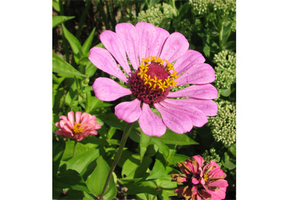If your garden is in a windy area, you have special challenges to deal with. Some plants do fine in high winds, but many do not.
High winds can adversely affect plants in many ways:
* The more and harder plants sway back and forth in the wind, the more they are pulled from the ground, weakening their roots.
* Wind, especially in combination with direct sun, can dry out soil.
* Plants can break or grow in a distorted, bent manner due to wind.
* Wind can spread airborne pathogens that carry plant diseases.
* Wind can lower the air temperature around plants to something less than what they need to grow.
One thing you can do to lessen these hazards of a windy garden is to partially block the wind, using walls, fences, screens, rocks, and hardy trees and shrubs.
But you also will want to stick with wind-resistant plants. Wind-resistant plants usually have small, narrow leaves and flexible stems that bend but don’t break. Here are a few plants that are especially good for a windy garden:
Bergenia
The bergenia is an Asian plant with pink and purple flowers that grows up to two feet high. Keep the area well watered if the wind is drying out the soil.
Boltonia
Boltonias grow to three to four feet tall and form mounds of white, pink, and purple flowers. The boltonia is a plant that normally is prone to powdery mildew, but high winds are effective in keeping it mildew-free.
Catmint
Similar to the better known catnip, and resembling russian sage, catmint’s foliage has spikes of flowers that bloom repeatedly during its growing season. Different varieties range from a foot tall to several feet tall.
Cesarini Blue
A good tree for a windy area is the cesarini blue pine. Cesarini blues grow six to eight feet tall. Their name comes from their blue-grey needles. They are easy to grow, not being too picky about soil, and not needing a lot of water.
Columbine
Columbines do best in rich, well watered soil, and partial sun. Different varieties differ a great deal in size. If yours is a container garden, consider the red hobbit or little treasure dwarf columbines.
Coneflower
The daisy-like flowers of the coneflower-or echinacea-come in orange, pink, white, or yellow. Coneflowers do not need a lot of watering.
Coreopsis
The coreopsis needs 180 days of frost-free weather. It does best in well-drained soil. Its flowers bloom in late summer, and are a bright yellow.
Daisy
The famous daisy is among the most wind-resistant of flowers, thriving in well-drained soil, and blooming in summer and fall.
Day Lily
Day lilies do not need a lot of water, and do better in cool temperatures. Their flowers can be orange, purple, white, or yellow.
Dryas
The dryas is a small plant of the rose family that can grow even in such inhospitable climates as that of Alaska, northern Canada, and high mountain elevations. Their flowers can be white or yellow.
Flax
Part of why flax is so wind-resistant is its strong, up to four foot deep roots. With flowers of blue, pink, purple, or white, it is used as a source of linen and as a medicinal herb.
Gaillardia
Gaillardias are drought-tolerant plants that do well in full sun, with striking large flowers with orange-red centers surrounded by gold.
Lady’s Mantle
Lady’s mantle plants form 12 to 18 inch mounds with soft, fuzzy, light green leaves, and full yellow flowers.
Mexican Feather Grass
Mexican feather grass grows up to three feet tall. It is dormant in the summer with straw-colored foliage, then it blossoms with bright green leaves and feather-shaped flowers. Many ornamental grasses are suitable for a windy garden. Other good choices include miscanthus and stipa.
Marie Bugnet Rose
The most wind-resistant of the roses, the marie bugnet is a squat, wide, three foot tall plant best known for its bright white flowers.
Russian Sage
Most russian sage is too big for a container garden, unless you choose a dwarf variety, such as little spire. Russian sage has gray-green leaves, and spires of rose-like purple flowers.
Zinnia
Zinnias are quick growing plants with bright flowers of many colors. A native of Mexico and the American Southwest, zinnias do fine in dry soil and prefer full sun.
Sources:
Fern, “More Plants for Part-Sun, Windy Balconies.” Life on the Balcony.
Fern, “What to Do on Windy Balconies That Also Get Scorched By the Sun?” Life on the Balcony.
Marjorie Gilbert, “Plants for a Windy Garden.” eHow.
Nikki Phipps, “Wind Resistant Plants for Your Windy Garden.” Gardening Know How.
